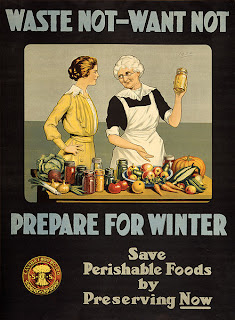Friday, March 18, 2011
Every year, the United States wastes 40 percent of the food it produces!
Couldn't resist re-copying this great article that I found at FoodDeclaration.org. Great web site. Look at this great WWI poster......... This poster is about 100 years old but its message is no less pertinent. Why? Because every year, the United States wastes 40 percent of the food it produces. That's enough food to fill the Rosebowl every day.
The U.S. Wastes 40 Percent of All Food Produced Per Year. How About We Stop Doing That?
by Allison Arieff
Jonathan Bloom, whom we introduced you to earlier this year, has been obsessing about that stat for a long time. Indeed, his book, American Wasteland: How America Throws Away Nearly Half of Its Food (and What We Can Do About It), points to food waste as one of the larger threats to our food supply.
Since the book's publication Bloom has been increasingly focused on reporting not just on that mind-boggling amount of waste but what we can do about it. I (Arieff) caught up with him at a brown bag lunch presentation at San Francisco's 18 Reasons earlier this week (where nary a sandwich crumb was left at the end). He suggests that there is legislation that could help stem the flow of food waste, by including language on food donation in the new Farm Bill, for example, or to streamline the tax deductions for food donation.
But, as Bloom points out, there are incredibly simple things we all can do to break the cycle of throwing out an average of 15 to 25 percent of our food annually per household (and the $1300 to $2200 we spend on it).
1. Shop smarter. Make a list to reduce your purchase of unnecessary items, plan meals, bring less food into your house. Since 25 percent is wasted, commit to buying 25 percent less food.
2. Focus on sensible portions. Portion sizes have increased as have the diameter of dinner plates. Pay attention to what's on your plate and think about equating value less with quantity than quality.
3. Ignore expiration dates. OK, so don't ignore them but approach with a fair amount of skepticism. If something is spoiled, you'll know it by the way it looks or smells not by the date on its packaging.
4. Love your leftovers. Don't just save them, eat them.
5. Befriend your freezer. It's a waste delayer.
And of course, there's always canning and preserving. For more tips including 17 Uses for Stale Bread, or to share some of your own, visit Bloom's blog, WastedFood.com .
Image from Library of Congress hington, D.C.
Subscribe to:
Posts (Atom)
